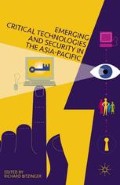Abstract
Militaries are future-oriented institutions.1 They consider the impact of advancing technology, changing political dynamics, and the implications of global economic shifts. Yet, as Niels Bohr reminds us, predictions are difficult, especially about the future. Very often, our predictions say more about our present: as Yogi Berra said, the future ain’t what it used to be.
Access this chapter
Tax calculation will be finalised at checkout
Purchases are for personal use only
Preview
Unable to display preview. Download preview PDF.
Notes
Department of Defense, Sustaining US Global Leadership: Priorities for the 21st Century Defense (Washington DC: US GPO, 2012), http://www.defense.gov/news/Defense_Strategic_Guidance.pdf (accessed 29 May 2014).
Department of Defense, Joint Operational Access Concept (Washington DC: US GPO, 2012), http://www.defense.gov/pubs/pdfs/JOAC_Jan%202012_Signed.pdf (accessed 29 May 2014).
Phillip Tetlock, Expert Political Judgement: How Good Is It? How Can We Know? (Princeton: Princeton University Press, 2005).
Charles Tilly, The Formation of National States in Western Europe (Princeton: Princeton University Press, 1975).
Alan D. Campen, The First Information War: The Story of Communications, Computers and Intelligence Systems in the Persian Gulf War (Fairfax VA: AFCEA Press, 1992).
Vice Admiral Arthur K. Cebrowski and John Gartska, “Network Centric Warfare: Its Origin and its Future,” Proceedings, Vol. 124, No. 1, January 1998.
Andrew Bacevich, The Pentomic Era (Washington DC: National Defense University Press, 1986), p. 3.
Douglas MacGregor, Breaking the Phalanx (London: Praeger, 1997), p. 37.
Lt. Col. H.R. McMaster, “Crack in the Foundation: Defense Transformation and the Underlying Assumption of Dominant Knowledge in Future War,” CSL Student Issue Paper, Vol. S03-03, November 2003, p. 56.
Thomas K. Adams, The Army After Next: The First Post Industrial Army (Westport CT: Praeger, 2006), p. 184.
Government Accounting Office, Defense Acquisitions: Improved Business Case is Needed for Future Combat Systems Successful Outcome (Washington DC: US GPO, 2006). Department of Defense, “Future Combat System (FCS) Program Transitions to Army Brigade Combat Team Modernization,” News Release, 23 June 2009, http://www.defense.gov/releases/release.aspx?releaseid=12763 (accessed 29 May 2014).
Christopher Coker, Waging War Without Warriors (Boulder CO: Lynne Rienner, 2002).
Elisabeth Bumiller, “A Day Job Waiting for a Kill Shot a World Away,” New York Times, 29 July 2012, http://www.nytimes.com/2012/07/30/us/drone-pilots-waiting-for-a-kill-shot-7000-miles-away.html?pagewanted=all&_r=2& (accessed 29 May 2014). Fighter pilot Shane Riza makes a convincing argument that UAV technology, even under full human control, changes our experience of combat, making it easier to kill and thus easier to go to war. See M. Shane Riza, Killing Without Heart (Dulles VA: Potomac Books, 2013).
John Ellis, The Social History of the Machine Gun (Baltimore: Johns Hopkins University Press, 1975).
Robert O. Work and Shawn Brimley, 20YY: Preparing for War in the Robotic Age (Washington DC: Center for a New American Security, 2013), p. 9.
Marshal McCluhan, The Gutenberg Galaxy (Toronto: University of Toronto Press, 1962); Peter F. Drucker, Landmarks of Tomorrow (New York: Harper and Row, 1957); Alvin Toffler, The Third Wave (New York: Bantam Books, 1980); Manuel Castells, The Rise of the Network Society (Malden MA: Blackwell, 2000); Daniel Bell, The Coming of the Post-Industrial Society (New York: Basic Books, 1973).
Vincent Moscoe, The Digital Sublime: Myth, Power and Cyberspace, (Cambridge: MIT Press, 2004).
Andrew Nikiforuk, The Energy of Slaves: Oil and the New Servitude (Vancouver: Greystone Books, 2012).
W. Brian Arthur. The Nature of Technology: What It Is and How It Evolves, (New York: The Free Press, 2009).
Michael Lewis, The Flash Boys: A Wall Street Revolt (New York: W.W. Norton, 2014).
Editor information
Editors and Affiliations
Copyright information
© 2016 Paul T. Mitchell
About this chapter
Cite this chapter
Mitchell, P.T. (2016). The Future Is upon Us: Failed Predictions, Boiling Frogs, and Gun Printers. In: Bitzinger, R.A. (eds) Emerging Critical Technologies and Security in the Asia-Pacific. Palgrave Macmillan, London. https://doi.org/10.1057/9781137461285_12
Download citation
DOI: https://doi.org/10.1057/9781137461285_12
Publisher Name: Palgrave Macmillan, London
Print ISBN: 978-1-349-69005-3
Online ISBN: 978-1-137-46128-5
eBook Packages: Political Science and International StudiesPolitical Science and International Studies (R0)

